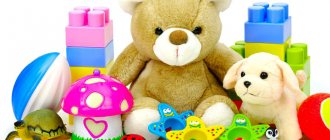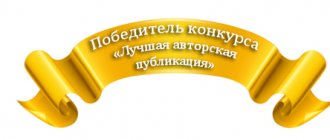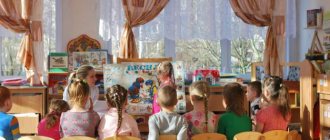Training seminar for teachers “Me and my team”
Goal: development of a self-confident personality, resistant to stress, with a culture of communication.
Tasks:
- show the characteristics of each person’s “I”;
- promote self-disclosure of each training participant.
- Contribute to the unity of the teaching staff.
Presenter : educational psychologist.
Participants : preschool teachers.
Duration : 2 hours (120 minutes).
Equipment and materials : metaphorical association cards (MAC), paper, colored pencils, colored paper, scissors, glue, audio recording of relaxation music, booklets “111 ways to take care of yourself.”
I. Initial stage. Getting ready to work.
1. Exercise “Greetings”
Goal: relieve muscle and emotional tension in participants.
Let's say hello in a special way:
- like Europeans (they shake hands);
- like the Japanese (bow);
- like Africans (with their noses).
2. Exercise “And I am such a tree!”
Goal: getting ready to work; give each participant the opportunity to express themselves as individuals.
The initial stage of working with the group. “Business card” of every teacher. Everyone who takes the MAC deck should immediately choose an image of the tree they like for themselves and say to themselves: “And I am such a tree!” It is advisable to comment on your choice.
3. Exercise “Getting to know yourself”
Goal: see your positive qualities, resource exercise.
It is necessary to answer the questions: “Who am I? What am I? Write the answer on a piece of paper in the shape of a heart.
Most will answer that he is a teacher, they can write their name. It is more difficult to answer the question: “What am I?” To make it easier to answer, you need to continue the following phrases:
- What I like most about myself...
- I love reading books about...
- my favorite hobby is...
- I am proud of myself as a woman -...
- how is your mom - …
- as a teacher -...
II. Main stage.
4. Message.
Communication is a complex process of establishing and developing contacts between people. The need for communication, the human need for a person is the most ineradicable and most humane. Is the ability to communicate given to a person by nature or does it need to be learned? Of course, people learn communication skills throughout their lives. Moreover, you can learn to communicate only in the process of communication itself, and not just from books and advice from knowledgeable people. And that is why when training teachers to behave constructively, for example, when interacting with parents, it is so important to practice certain skills in specific situations. In this regard, one of the effective forms of training can be not a lecture, but a training, a business game that allows each participant, using his or her existing life experience, to acquire and consolidate new skills of interaction with others.
In teaching practice, communication is the most important factor in professional success. “High technique of pedagogical communication is not only one of the components, but also the leading component of pedagogical mastery.” That is why learning and practicing communication skills become the primary task of a teacher who strives for effective interaction with colleagues, with children and their parents. In the process of human-human interaction, everything turns out to be important: what we say, how we say it, how we perceive the information of our communication partner. Representatives of different professions can perceive the same communication partner differently, highlighting various features of the interlocutor (which, in their opinion, are more important). For example, when studying the characteristics of teachers’ perceptions, it is noted that they remember well and can describe from memory the posture, gestures, facial expressions and speech of their students, as well as the state of their clothing. Teachers also have a higher impact on people, a large number of communication skills, the use of expressive movements, facial expressions and gestures, good sensitivity in the field of communication, and a developed manipulative style.
Traditionally, all means of communication are divided into verbal, nonverbal and paralinguistic. Verbal means include the words that we pronounce in the process of communication; non-verbal – gestures, facial expressions, distances, communication positions, postures; paralinguistic – timbre, voice tempo, intonation, pauses.
In some cases, including in situations of pedagogical communication, one of the parties experiences difficulties in making contact with a partner. Sometimes teachers who do not have sufficient experience interacting with parents and who also have certain personal traits (shyness, lack of self-confidence, etc.) think with fear about the upcoming conversation with some mother or grandmother, and even more so about speaking at a parents’ meeting. meeting. For those who experience uncertainty and even fear of public speaking, there are the following recommendations:
- Accept that incidents during public speaking are inevitable;
- Maintain composure;
- Get out of difficult situations with dignity;
- Forgive yourself for your mistakes (then others will forgive you too);
- Practice the skill of confident speaking in practice as often as possible;
- Record and listen to your speeches on audio and video tape, analyze them;
- Remain yourself, as your loved ones and colleagues know you;
- In cases of special concern, it is advisable to take care of several “preparations” for starting a conversation in advance.
Communication can be different. And for it to be productive, it is very important to remember such communication methods as “Active listening” and “I am statements”.
(Remember a few methods and examples.)
Typical Active Listening
Reflection of emotions. It consists of a direct description of the experiences that an adult noticed in the child’s behavior:
“You’re excited,” “You’re upset,” “You’re uncomfortable.”
Verbatim repetition of the main points expressed by the mentee. Repetition of statements should be preceded by introductory phrases like:
“As far as I understand you...”, “Do you think that...”.
Methods of clarification. You ask for clarification of certain provisions and statements.
For example: “Please clarify…”, “What exactly makes you think that?”
Nodding your head and using interjections “Yeah”, “Uh-huh”. This carries the message:
"I'm here and I'm listening." However, it is better to use "Yes".
The question is an echo.
Child: “I’m in a bad mood...”
Adult: “Are you in a bad mood?”
Emotions - “wow”, “ah”, “great”, laughter, “well, well”, mournful expression, etc.
"I am the message"
Speak in the first person, report about yourself, about your experience, and not about him, not about his behavior.
5. Effective Communication Techniques
It is very important for a person to be listened to, heard and understood, and if we learn to be good listeners, we are guaranteed success in communication. During listening, tasks are solved: the content of the message is perceived and the emotional state of the interlocutor is captured.
Ability to be observant and attentive to all group members. Feeling of empathy.
Question: How does this ability help us communicate effectively? (Answers from participants.)
Exercise “Dividing a group into subgroups according to a certain criterion”
Host: One of the participants goes out the door and stays there for some time. In the meantime, we will divide into groups according to some criterion we have chosen. The sign must be visually recorded and unambiguously divide the group into two parts. The groups are located in different places so that they are separated spatially. The returning participant must determine on what basis the group was divided into two parts. The game is repeated again with the same main participant, but the group is divided according to a different criterion.
Each of us has something to learn about communication skills..
6. Exercise “Four Positions”
Goal: awareness of one’s own preferences and organization of communication space; awareness of differences in the perceptions and emotions of different people in the same situation; overcoming stereotypes.
The facilitator invites the participants to split into pairs.
1. The presenter asks the pairs to distribute themselves throughout the room so that each pair is as far away from the others as possible, and place their chairs with their backs facing each other, close to each other.
Leading. Now you will sit on the chairs and talk for a minute and a half without turning your body. You choose the topic yourself, or I will suggest it to you. You have some time to make this choice. When I say “start!”, you will begin the conversation.
The presenter keeps track of the time and, when one and a half minutes have elapsed, says “stop.”
2. Presenter. Now have one of you sit and the other stand directly opposite your partner, and on command you will continue the conversation. The topic is the same, if you want, you can take a different one. A minute and a half after the command “start!” I'll stop you.
3. Partners change places in the position “one stands, the other sits” and again talk for one and a half minutes.
4. Partners talk while sitting facing each other.
Everyone sits in a circle, the leader invites everyone to say in what position it is most convenient and pleasant for him to talk, and in what position it is least pleasant.
7. Desert Storm cocological test. Cognitive test.
Goal: to get answers to questions about yourself - what kind of partner do you need, are there reliable people around you, are you standing firmly on the ground.
Cocological tests - Japanese games. Kokology is the science that deals with the study of "kokora", which means "mind" or "spirit" in Japanese.
III. Completion.
8. Exercise “Gift”
Goal: set the mood for positive emotions towards each other, exchange good wishes.
Each participant chooses the card they like (MAK), then writes down the positive emotions it evokes on a piece of paper, as well as their first and last name. The presenter offers to exchange cards and texts with each other. Based on the information received, everyone creates a gift card with wishes. Any art materials, clippings from magazines and newspapers, and plasticine can be used. Then, upon completion of work with finished images, all postcards are given to the presenter.
As a result, participants receive unique gifts containing their own thoughts processed by another person.
9. Exercise “A trickle of success”
The presenter asks to divide into groups of equal size and stand in parallel columns facing each other, as in the game “Stream”.
The presenter announces the first and last name of the last participant in the column, for example: “Your applause for Masha Petrova.” Before the start of the movement, the presenter collects all the cards with good wishes for the ceremonial presentation. The participant begins to move between the columns, and the rest support the walker with stormy applause. When the participant reaches the end of the column, the presenter thanks him for participating in the training and hands him a sheet with a finished image and wishes. Present. The exercise ends when all participants have passed through a trickle of success.
10. Reflection. Feedback.
Each participant needs to answer the question “What useful and interesting things will he take away from this lesson, what did he discover for himself, what would be his wishes.”
(If time permits, you can use MAC. Draw an open card with the question “What am I leaving class for?”
Literature.
- Monina G.B. Communicative training (teachers, psychologists, parents) / G. B. Monina, E. K. Lyutova-Roberts. - St. Petersburg: Speech, 2013.
- Zhigamont N. Colors and feelings. Associative metaphorical maps in art therapy. – St. Petersburg-Moscow: Rech, 2016.
- Katz G., Mukhamatullina M. Metaphorical cards. Guide for a psychologist. – Moscow: Genesis, 2014.
My kindergarten
Author: Maria Sergeevna Shpet , teacher-psychologist, MAOU Secondary School No. 30 DO, Tomsk.
Explanatory note
Relevance
Group cohesion is a necessary condition for creating a comfortable microclimate in the team. Group cohesion is promoted by: a positive emotional state of teachers, a friendly, inviting atmosphere in the group; positive relationships and sympathy between participants, mutual understanding. Thus, when a comfortable microclimate is created in a group, its participants gain confidence and strive to work and create. Team building training is one of the effective ways to create such an atmosphere.
Program goal: increasing team cohesion
Tasks:
- Improving the emotional state of teachers
- Promote positive relationships and mutual understanding between teachers
- Relieving emotional stress of teachers
Progress of the training
Teacher-psychologist: Good afternoon! I am glad to welcome you to our training! Today we have the opportunity to relax a little, relax, play, learn a little more about ourselves and our colleagues, and most importantly, become a little closer to each other.
Exercise "Let's say hello"
Psychologist: At the beginning of our meeting, I propose to say hello, but we will do it in an unusual way. First of all, we need to break into pairs (teachers form pairs). If you hear 1 clap, we shake hands, 2 claps, we shake shoulders, 3 claps, we shake our backs. During the task we remain silent, only parts of our body say hello. When I ring the bell, your task is to find a new partner.
Game "Magic Hat"
Psychologist: What can make a meeting pleasant? (statements from teachers). A compliment will make any meeting pleasant. We will pass the hat around in a circle while the music is playing, when the music stops, the one who still has it puts it on himself and pays a compliment to the person sitting on the right. It is necessary not only to receive a compliment, but also to return it. A compliment is accepted in a certain form: Yes, it is! And I…(a positive quality is added) and the compliment is returned to the speaker.
Exercise “Recognize the drawing”
Teacher-psychologist:
Each of us received a compliment. A compliment improves your mood and allows you to look at yourself differently. Please draw in 5 (10) minutes a portrait of yourself, how you see yourself in the team or want to see yourself. There is no need to sign the drawings.”
After completing the work, the trainer collects the drawings into a common pile. Then he takes each drawing out of the pack, attaches it to the board or flipchart (you can first pass the drawing around so that everyone can take a closer look at it) and discusses it with the group on the following questions:
- What is this person like?
- Who could it be?
Participants guess the author of the drawing. After the group has found out who the author of the drawing was, the coach asks him to pick a flower and finish the sentence he started.
Exercise "Flower"
Each flower has a saying written on it that needs to be completed: I am proud... The thing I want most... The person I admire is... The thing I love the most... I dream... Three places I've lived.. Three things I like... Three things that I don't like... My hobby... You don't know about me yet that I...
Exercise "I'm just like you"
Teacher-psychologist: The previous exercise led me to the idea that we are all different, but in some ways we are similar. I have a ball in my hands. The one who gets this ball throws it to any teacher and, calling him by name, explains why he is the same: I am the same as you, because...”. The one to whom the ball was thrown expresses agreement or disagreement and throws the ball to the next person.
Exercise “Learn through touch”
Psychologist: Do you think we have learned enough about each other to recognize each other without words? (statements from teachers) I suggest one of you now enter the center of the circle, sit on a chair, put your hands on your knees, palms up, and close your eyes. We will all, in no particular order, come up to him and put our hands on his palms. The person sitting on the chair must understand whose hands these are. Every time we will clap our hands if the person who comes up is named correctly, and “no if there is a mistake.”
Exercise “Heart of the Team”
Teacher-psychologist: Each team has its own heart. I propose to create the heart of our team. To do this, write your name on a piece of paper and fold it. This is necessary so that each of you can draw lots with someone’s name. Come up with a friendly, pleasant phrase addressed to the person whose name you drew by lot. Take a small heart and write down what you came up with on it. Now, look what a big heart I brought. It will become the heart of our team after we glue all the small hearts onto our big heart (teachers glue small hearts to music)
Exercise “What I Learned”
Teacher-psychologist: Our training today is coming to an end. I'd really like to get feedback. Let's light a candle and pass it around. Whoever holds the candle in his hands says that he liked it, what he was surprised by, what he learned, what was most important to him.
List of used literature:
- Aralova M. A. Formation of a preschool educational institution team. Psychological support - Moscow: Sfera, 2005. - 60 p.
- Vachkov, I.V. Basics of group training. – M.: Os-89, 2000.
- Monina, G.B., Lyutova-Roberts, E.K. Communication training (teachers, psychologists, parents). - St. Petersburg: Rech, 2007. - 224 p.
- Psychological training in a group: Games and exercises: Textbook / Author-comp. T.L. Buka, M.L. Mitrofanova. – 2nd ed. – M.: Psychotherapy, 2008. – 144 p.
- Samukina, N.V. "Games that are played..." Psychological workshop. – Dubna: Phoenix+, 2000.
- 18 training programs. Guide for professionals / Scientifically ed. V.A. Chicker. - (Psychological training) - M.: Rech, 2008. - 368 p.





